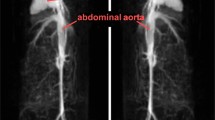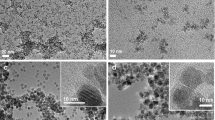Abstract
The physical and chemical parameters involved in the design and synthesis of biospecifically targeted nanoparticulate contrast media for magnetic resonance molecular imaging (MRMI) were explored in this pilot investigation. Latex nanoparticles 100, 400 and 900 nm in diameter were doubly derivatised, first with tomato lectin and then with gadoliniumIII-diethylenetriamine pentaacetic acid (Gd-chelates) to target them to epithelial and endothelial glycocalyceal N-glycans and to generate contrast enhancement in magnetic resonance imaging (MRI). After intravenous injection into mice, human placental cotyledons or human Vena saphena magna, contrasty images of the vascular structures were obtained in 1.5 T MRI with spatial resolution 0.1 mm in the imaging plane and 0.6 mm in the z axis, persisting >60 min and resistant to washing out by buffer rinses. Ultrastructural analysis of the nanoparticles revealed the targeting groups at the nanoparticle surfaces and the distribution of the Gd-chelates within the nanoparticles and enabled counts for use in determining relaxivity. The relaxivity values revealed were extremely high, accounting for the strong MR signals observed. Occasionally, nanoparticles larger than 100 nm were seen in close spatial association with disrupted regions of cell membrane or of collagen fibrils in the extracellular matrix. The data suggest that 100-nm nanoparticles generate adequate contrast for MRMI and cause least disruption to endothelial cell surfaces.





Similar content being viewed by others
References
Ahmed A, Bonner C, Desai TA (2001) Bioadhesive microdevices for drug delivery: a feasibility study. Biomed Microdevices 3:89–96
Alon R, Chen S, Puri KD, Finger EB, Springer TA (1997) The kinetics of L-selectin tethers and the mechanics of selectin-mediated rolling. J Cell Biol 138:11169–11180
American College of Radiology white paper on MR safety 2004 update and revisions (2004) Am J Radiol 182:111–114
Chigaev A, Blenc AM, Braaten JV, Kumaraswamy N, Kepley CL, Andrews RP, Oliver JM, Edwards B, Prossnitz Er, Larson RS, Sklar LA (2001) Real time analysis of the affinity regulation of ∝4-integrin. J Biol Chem 276:48670–48678
Christiansen JP, French BA, Klibanov AL, Kaul S, Lindner JR (2003) Targeted tissue transfection with ultrasound destruction of plasmid-bearing cationic microbubbles. Ultrasound Med Biol 29:1759–1767
Corsi DM, Elst LV, Muller RN, van Bekkum H, Peters JA (2001) Inulin as a carrier for contrast agents in magnetic resonance imaging. Chem Eur J 7:64–71
D’Ambrosio D, Albanesi C, Lang R, Girolomoni G, Sinigaglia F, Laudanna C (2002) Quantitative differences in chemokine receptor engagement generate diversity in integrin-dependent lymphocyte adhesion. J Immunol 169:2303–2312
Debbage, PL (1996) A systematic histochemical investigation in mammals of the dense glycocalyx glycosylations common to all cells bordering the interstitial fluid compartment of the brain. Acta Histochem 98:9–28
Debbage PL, Sölder E, Seidl S, Hutzler P, Hugl B, öfner D, Kreczy A (2001) Intravital lectin perfusion analysis of vascular permeability in human micro- and macro-blood vessels. Histochem Cell Biol 116:349–359
Debray H, Decout D, Strecker G, Spik G, Montreuil J (1981) Specificity of twelve lectins towards oligosaccharides and glycopeptides related to N-glycosylproteins. Eur J Biochem 117:41–55
Ellegala DB, Leong-Poi H, Carpenter JE, Klibanov AL, Kaul S, Shaffrey ME, Sklenar J, Lindner JR (2003) Imaging tumor angiogenesis with contrast ultrasound and microbubbles targeted to \(\alpha_{v}\ss_{3}\). Circulation 108:336–341
Elson DA, Thurston G, Huang LE, Ginzinger DG, McDonald DM, Johnson RS, Artbeit JM (2001) Induction of hypervascularity without leakage or inflammation in transgenic mice overexpressing hypoxia-inducible factor-1α. Genes Dev 15:2520–2532
EU, 2004: FP6–2004-NMP-NI-4 (http://fp6.cordis.lu/nmp/call_details.cfm
Feldherr CM, Lanford RE, Akin D (1992) Signal-mediated nuclear transport in simian virus 40-transformed cells is regulated by large tumor antigen. Proc Natl Acad Sci USA 89:11002–11005
Feng D, Nagy JA, Dvorak HF, Dvorak AM (2002) Ultrastructural studies define soluble macromolecular, particulate, and cellular transendothelial cell pathways in venules, lymphatic vessels, and tumor-associated microvessels in man and animals. Microsc Res Tech 57:289–326
Friend DR (2004) Drug delivery to the small intestine. Curr Sci 6:371–376
Hanley WD, Wirtz D, Konstantopoulos K (2004) Distinct kinetic and mechanical properties govern selectin-leukocyte interactions. J Cell Sci 117:2503–2511
Hauff P, Reinhardt M, Briel A, Debus N, Schirner M (2004) Molecular targeting of lymph nodes with L-Selectin ligand-specific US contrast agent: a feasibility study in mice and dogs. Radiology. DOI 10.1148/radiol.2313030425
Huang J, Frischer JS, Serur A, Kadenhe A, Yokoi A, McCrudden KW, New T, O’Toole K, Zabski S, Rudge JS, Holash J, Yancopoulos GD, Yamashiro DJ, Kandel JJ (2003) Regression of established tumors and metastases by potent vascular endothelial growth factor blockade. Proc Natl Acad Sci USA 100:7785–7790
Irache JM, Durrer C, Duchene D, Ponchel G (1994) Preparation and characterization of lectin-latex conjugates for specific bioadhesion. Biomaterials 15:899–904
Jain RK, Stroh M (2004) Zooming in and out with quantum dots. Nat Biotechnol 22:959–960
Jenning V, Gysler A, Schaefer-Korting M, Gohla SH (2000) Vitamin A loaded solid lipid nanoparticles for topical use: occlusive properties and drug targeting to upper skin. Eur J Pharm Biopharm 49:211–218
Johannson LO, Bjørnerud A, Ahlström HK, Ladd DL, Fujii DK (2001) A targeted contrast agent for magnetic resonance imaging of thrombus: implications of spatial resolution. J Magn Res Imag 13:615–618
Kato T, Yashiro T, Murata Y, Herbert DC, Oshikawa K, Bando M, Ohno S, Sugiyama Y (2002) Evidence that exogenous substances can be phagocytized by alveolar epithelial cells and transported into blood capillaries. Cell Tiss Res 311:47–51
Kawashima H, Sueyoshi S, Li H, Yamamoto K, Osawa T (1990) Carbohydrate binding specificities of several poly-N-acetyllactosamine-binding lectins. Glycoconj J 7:323–334
Kiessling F, Greschus S, Lichy M, Bock M, Fink C, Vosseler S, Moll J, Mueller MM, Fusenig NE, Traupe H, Semmler W (2004) Volumetric computed tomography (VCT): a new technology for noninvasive, high-resolution monitoring of tumor angiogenesis. Nat Med 10:1133–1138
Kilpatrick DC, Weston J, Urbaniak SJ (1983) Purification and separation of tomato isolectins by chromatofocusing. Anal Biochem 134:205–209
King CP, Li MD, Bednarski MD (2002) Vascular-targeted molecular imaging using functionalized polymerized vesicles. J Magn Res Imag 16:388–393
Koenig SH (1991) From the relaxivity of Gd(DTPA)2- to everything else. Magn Reson Med 22:183–190
Krasnici S, Werner A, Eichhorn ME, Schmitt-Sody M, Pahernik SA, Sauer B, Schulze B, Teifel M, Michaelis U, Naujoks K, Dellian M (2003) Effect of the surface charge of liposomes on their uptake by angiogenic tumor vessels. Int J Cancer 105:561–567
Lauffer RB (1987) Paramagnetic metal complexes as water proton relaxation agents for NMR imaging: theory and design. Chem Rev 87:901–927
Laurent S, Elst LV, Fu Y, Muller RN (2004) Synthesis and physicochemical characterization of Gd-DTPA-B(sLex)A, a new MRI contrast agent targeted to inflammation. Bioconjug Chem 15:99–103
Laus S, Ruloff R, Tóth E, Merbach AE (2003) GdIII complexes with fast water exchange and high thermodynamic stability: potential building blocks for high-relaxivity MRI contrast agents. Chem Eur J 9:3555–3566
Lecca P, Priami C, Quaglia P, Rossi B, Laudanna C, Constantin G (2004) A stochastic process algebra approach to simulation of autoreactive lymphocyte recruitment. Simulation 6:273–288
Lee YC (1992) Biochemistry of carbohydrate-protein interaction. FASEB J 6:3193–3200
Nachbar MS, Oppenheim JD, Thomas JO (1980) Lectins in the US diet. Isolation and characterization of a lectin from the tomato (Lycopersicon esculentum). J Biol Chem 255:2056–2061
Neeman M, Dafni H (2003) Structural, functional, and molecular MR imaging of the microvasculature. Annu Rev Biomed Eng 5:29–56
NIBIB 2004: National Institute for Biomedical Imaging and Bioengineering at http://www.nibib.nih.gov
Nicolle GM, Tóth E, Schmitt-Willich H, Radüchel B, Merbach AE (2002) The impact of rigidity and water exchange on the relaxivity of a dendritic MRI contrast agent. Chem Eur J 8:1040–1048
NIH, 2004: National Institutes of Health at http://nihroadmap.nih.gov
Ogan MD, Schmiedl U, Moseley ME, Grodd W, Paajanen H, Brasch RC (1987) Albumin labeled with Gd-DTPA. Invest Radiol 22:665–671
Peumans WJ, Rougé P, Van Damme EJM (2003) The tomato lectin consists of two homologous chitin-binding modules separated by an extensin-like linker. Biochem J 376:717–724
Porter GA, Palade GE, Milici AJ (1990) Differential binding of the lectins Griffonia simplicifolia I and Lycopersicon esculentum to microvascular endothelium: organ-specific localization and partial glycoprotein characterization. Eur J Cell Biol 51:85–95
Sipkins DA, Cheresh DA, Kazemi MR, Nevin LM, Bednarski MD, Li KC (1998) Detection of tumor angiogenesis in vivo by alphaVbeta3-targeted magnetic resonance imaging. Nat Med 4:623–626
Stark DD, Bradley WG (eds) (1999) Magnetic resonance imaging, vol I, 3rd edn. Mosby, 672 pp. ISBN 0-8151-8518-9 (see also: http://www.mosby.com/Stark-Bradley)
Taylor JS, Reddick WE (2000) Evolution from empirical dynamic contrast-enhanced magnetic resonance imaging to pharmacokinetic MRI. Adv Drug Deliv Rev 41:91–110
Thomas VH, Yang Y, Rice KG (1999) In vivo ligand specificity of E-selectin binding to multivalent sialyl Lewisx N-linked oligosaccharides. J Biol Chem 274:19035–19040
Van Damme EJM, Barre A, Rougé P, Peumans WJ (2004) Potato lectin: an updated model of a unique chimeric plant protein. Plant J 37:134–144
Vestweber D, Blanks JE (1999) Mechanisms that regulate the function of the selectins and their ligands. Physiol Rev 79:181–213
Voura EB, Jaiswal JK, Mattoussi H, Simon SM (2004) Tracking metastatic tumor cell extravasation with quantum dot nanocrystals and fluorescence emission-scanning microscopy. Nat Med 10:993–998
Watkin KL, McDonald M (2002) Multi-modal contrast agents: a first step. Acad Radiol 9:S285–S289
Weissleder R, Mahmood U (2001) Molecular imaging. Radiology 219:316–333
Wieser E, Strohmeyer D, Rogatsch H, Horninger W, Bartsch G, Debbage P (2005) Access of tumor-derived macromolecules and cells to the blood: an electron microscopical study of structural barriers in microvessel clusters in highly malignant primary prostate carcinomas. The Prostate 62:123–132
Winter PM, Morawski AM, Caruthers SD, Fuhrhop RW, Zhang H, Williams TA, Allen JS, Lacy EK, Robertson JD, Lanza GM, Wickline SA (2003) Molecular imaging of angiogenesis in early-stage atherosclerosis with \(\alpha_{5}\ss_{3}\) –integrin-targeted nanoparticles. Circulation 108:2270–2274
Xie H, Tkachenko AG, Glomm WR, Ryan JA, Brennaman MK, Papanikolas JM, Franzen S, Feldheim DL (2003) Critical flocculation concentrations, binding isotherms, and ligand exchange properties of peptide-modified gold nanoparticles studied by UV-visible, fluorescence, and time-correlated single photon counting spectroscopies. Anal Chem 75:5797–5805
Yang M, Baranov E, Moossa AR, Sheldon P, Hoffman RM (2000) Visualizing gene expression by whole-body fluorescence imaging. PNAS 97:12278–12282
Zeng X, Murata T, Kawagishi H, Usui T, Kobayashi K (1998) Analysis of specific interactions of synthetic glycopolypeptides carrying N-acetyllactosamine and related compounds with lectins. Carbohydr Res 312:209–217
Acknowledgements
The Austrian National Bank supported all stages of this work through the Jubilee Fund, projects 9273 and 10844. The Medical Research Fund Tirol provided financial support to this work. The Faustus Forschung Translational Drug Development AG provided financial support to this work. The Austrian Nano-Initiative co-financed this work as part of the Nano-Health project (no. 0200), the sub-project NANO-MRI being financed by the Austrian FWF (Fonds zur Förderung der Wissenschaftlichen Forschung) (Project no. N210-NAN). Dr. A. Wilder and Dr. T. Hanitz (Analytical Systems GmbH, Oberhausen, Germany) provided significant logistical support and insights concerning photon correlation spectroscopy. We thank Silvia Fill, Angelika Flörl and Beate Schimpfössl for excellent technical assistance. Our analyses of the various types of images would not have been possible without the excellent supporting services provided by Dr. J. Stöckler and Dr. W. Morscher of the Central Informatics Service of the University of Innsbruck.
Author information
Authors and Affiliations
Corresponding author
Rights and permissions
About this article
Cite this article
Paschkunova-Martic, I., Kremser, C., Mistlberger, K. et al. Design, synthesis, physical and chemical characterisation, and biological interactions of lectin-targeted latex nanoparticles bearing Gd–DTPA chelates: an exploration of magnetic resonance molecular imaging (MRMI). Histochem Cell Biol 123, 283–301 (2005). https://doi.org/10.1007/s00418-005-0780-7
Accepted:
Published:
Issue Date:
DOI: https://doi.org/10.1007/s00418-005-0780-7




